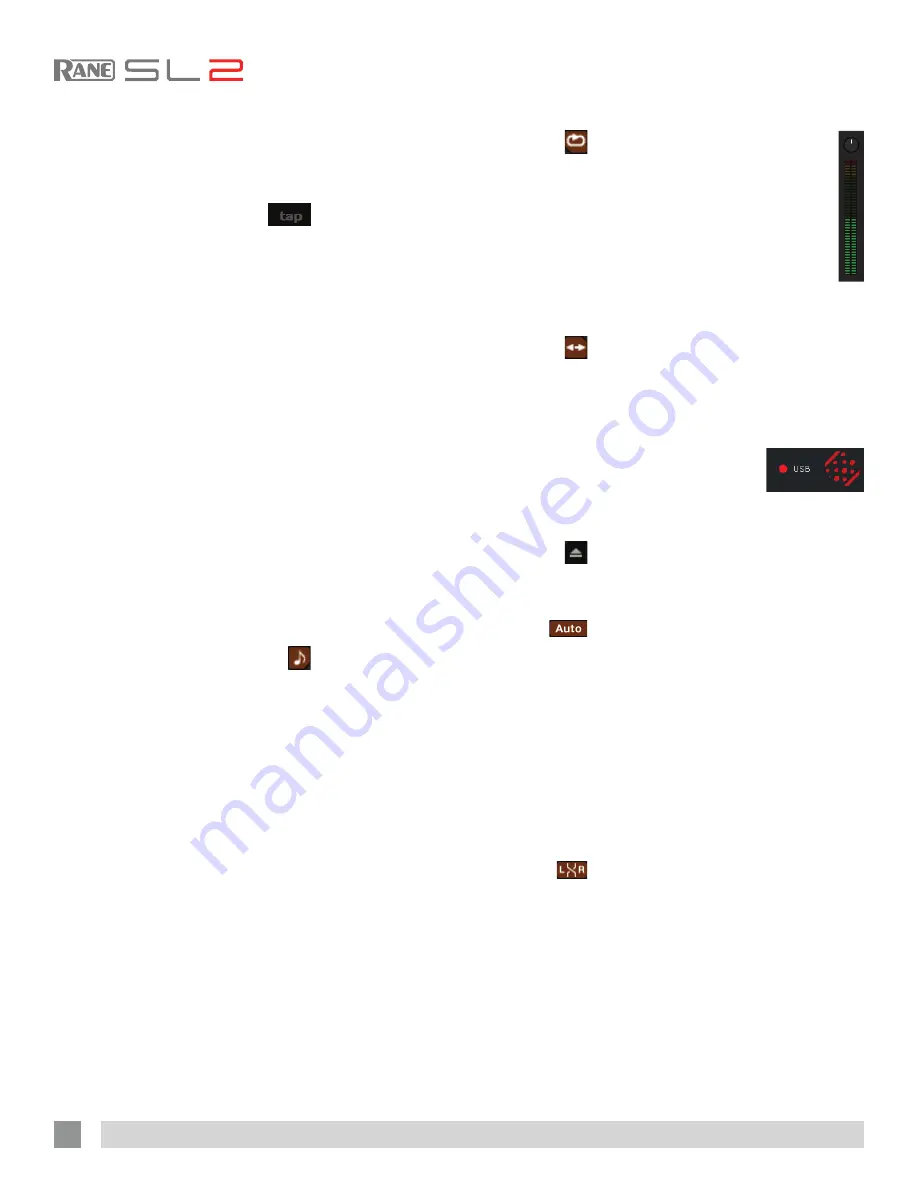
RANE SL2 FOR SERATO SCRATCH LIVE • OPERATOR’S MANUAL 2.4.4
NOTE: It is normal for the tracking
indicator to be red when cueing or
scratching.
Tap Tempo
For tracks with no BPM
information, there is a tap tempo
button displayed where the BPM usually
is, in the song info area. Pressing alt-
space bar activates the tempo tapper
(press alt-space bar a second time to
activate the tempo tapper on the Right
Virtual Deck). Tap the space bar along
with the beat. After you’ve tapped the
first beat, you can switch to double time
tapping, half time, start of each bar etc.
The range is set by the first two taps, after
that you can switch to any steady rhythm
you feel comfortable with – quarter notes,
half note, whole notes. Esc resets the
BPM, Enter saves the BPM to the track.
You can use the mouse if you prefer.
Your CD player or turntable’s pitch slider
doesn’t need to be at zero, we do the
math for you. You can also use the tempo
tapper when no song is loaded, for finding
the BPM of regular records, for example.
Key Lock
When Key Lock is on, the key or
pitch of the song stays locked at
what it would be if the track was playing
at normal speed, regardless of the platter
speed of the turntable or CD player. Key
Lock has scratch detection, so that it
automatically turns off when scratching
for a natural scratching sound. Turn Key
Lock on or off by clicking the button to the
top right of the Virtual Deck.
TIP: F5 and F10 will turn Key Lock on
and off for the Left and Right Decks
respectively.
Repeat
Use the Repeat function to repeat
the song across the entire length of
the control record.
TIP: Short “loop” samples can be
turned into a continuous track using
the Repeat function. The loops must be
less than 10 seconds long, and cut at
the start and end of a bar.
Censor
Use the censor button to “mask”
parts of a song, or use as a special
effect. When you press the censor button,
the track starts playing backwards from
that point. When you release the censor
button, the track plays forward from the
point you would have been, had you not
pressed the censor button. Censor is
available only in REL and INT Modes.
Eject
This ejects the track playing or
loaded from it’s Virtual Deck.
Autoplay
Click the
Auto
button to enable
autoplay. With this setting turned
on, when one track finishes playing, the
next track starts automatically. Load from
a crate to play through the songs in that
crate, or from your library to play through
your library. Autoplay works in both REL
and INT modes.
Play from start
must be
checked in the Playback tab of the Setup
screen for autoplay to work correctly.
See
“Play From Start” on page 33
.
Reverse Input Control
Swaps the Left Deck input (3 & 4)
with the Right Deck input (5 & 6) of
the SL2.
This transfers control over to the
alternate Virtual Deck. For example, the
physical record on the right hand side
now controls the Left Virtual Deck. This
essentially lets you continue mixing, but
just using one turntable.
See “Mixing
with One Turntable or CD Player” on
page 30.
Track Gain
Use the track gain knob to balance
the volume of the tracks in your
library. Any adjustment made to the
gain of a track is saved with the file,
and will be reapplied to the entire
track when it is loaded again. The
level meter shows the level sent to
the hardware interface after both
individual track gain and master
gain adjustment. Ctrl-click the knob to
reset it to 12 o’clock.
NOTE: For automatic gain setting of
your tracks,
see “Use Auto Gain” on
page 33.
USB Dropout Indicator
The USB dropout
indicator on the main
screen is a useful
troubleshooting
tool if you have problems with audio
dropouts. Such dropouts are caused by
an interruption in passing the audio to the
Scratch Live hardware interface. If such an
interruption (or dropout) occurs, a red light
will appear briefly, just to the left of the
Scratch Live logo at the top of the screen.
The light will be red for one second, and
then orange for four seconds.
If you experience USB drop outs:
• Increase the USB Buffer Size.
See “USB
Buffer Size (Latency)” on page 32
.
• Try closing other applications that are
running the same time as Scratch Live.
• Try turning off background tasks, for
example, wireless networking.
• If your CPU load is very high, try
decreasing the Maximum Screen
Updates setting in the Display tab of the
Setup screen.
See “Maximum Screen
Updates” on page 35.
14





























